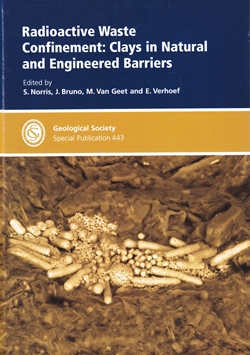 The current scientific consensus for the safest long-term management of higher-activity radioactive wastes is through geological disposal in engineered facilities constructed at an appropriate crustal depth, within stable geological formations (the geological disposal facility or ‘repository’). Repository development on a specific site requires the integrated and systematic analysis of the characteristics of the waste to be ‘emplaced’, the enclosing engineered barriers and the site’s host rock and its geological setting. Three main host rock types are usually considered for geological disposal: crystalline rocks, evaporites (salt) and clays.
The current scientific consensus for the safest long-term management of higher-activity radioactive wastes is through geological disposal in engineered facilities constructed at an appropriate crustal depth, within stable geological formations (the geological disposal facility or ‘repository’). Repository development on a specific site requires the integrated and systematic analysis of the characteristics of the waste to be ‘emplaced’, the enclosing engineered barriers and the site’s host rock and its geological setting. Three main host rock types are usually considered for geological disposal: crystalline rocks, evaporites (salt) and clays.
This GSL Special Publication concentrates on the importance of clays and other argillaceous materials in the development of geological disposal systems. Characteristically, clays display properties which can be exploited both as host rock and material for engineered barriers (as buffer, backfill or sealing material). Properties include low permeability, diffusive transport, retention capacity, buffering effects, self-sealing capacity, stability, vertical homogeneity and lateral continuity, which make clays significant barriers to radionuclide and chemical contaminant migration towards the surface environment.
Based upon the 6th international ‘clay conference’ hosted by the Belgium National Radioactive Waste Management Agency (ONDAF/NIRAS) in 2015, the volume contains twenty-five papers grouped into six interrelated and multi-disciplinary topic areas: large-scale geological characterisation, general strategy for clay-based systems, geomechanics, mass transfer, bentonite evolution and gas transfer. These topic areas demonstrate the diversity of current geological repository research. Clay characterisation studies relevant to the confinement of radionuclides range from the fundamental process level, to the overall understanding of the performance and safety at geological and repository scales. Emphasis is placed on the modelling of processes operating at the mineralogical level within the argillaceous barriers.
The contributions are well-written and edited, complemented with appropriate figures, photographs and data-tables. A minor presentational criticism is that several data graphs are difficult to discriminate, reproduced as grey-scale images (perhaps the original images may been produced in colour and inadvertently transferred) in the print copy - unfortunately distracting from the details described. Overall, a recommended read and valuable reference work for practising geoscientific professionals within the radioactive waste management sector.
Reviewed by Mark Griffin
RADIOACTIVE WASTE CONFINEMENT: CLAYS IN NATURAL AND ENGINEERED BARRIERS by NORRIS. S, BRUNO J, VAN GEET M, & VERHOEF E (editors). Geological Society of London Special Publication No 443. 2017. Geological Society of London. ISBN 978-1-78620-273-4. Hbk. 376pp. ISSN 0305-8719. List Price: £100.00, Fellows’ Price: £50.00. W: www.geolsoc.org.uk/SP443.